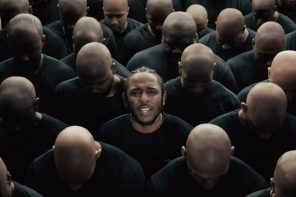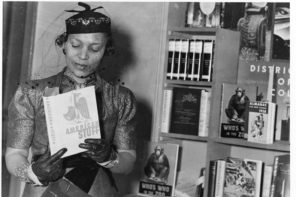At some point, we have to give it up. I know it will be hard. I know it will be sad. But sometime soon, hopefully very soon, we have to let go. Maybe a communal scrapbooking will help. Or perhaps someone can commission some sculpture. But no matter what, no matter how hard, we have got to consider the possibility that one of the more precious categories of religious classification is also one of our most pernicious. I speak today of “The Black Church.”
Capital letters are optional. Sometimes, especially lately, the black church is a more low-slung image, not needing capitals to press deeply its representational heft. Thanks to the recent Wright campaign controversy, we know some things for sure. Courtesy of coverage both journalistic and blogospheric, we now know that the black church is something that possesses a history, receives regular attack, may be attended for multiple years, possesses contrasting ritual patterns to European churches (“different, but not deficient”), emerged from oppression, and has been invisible yet visible, reconciling and radical, egalitarian and charismatic. What we have learned lately is that t/The b/Black c/Church is the explanatory signifier for ecstatic worship practices, political activism, and social organization among a color-coded cadre of Christians.
The media (and men of media) are not solely to blame for the perpetuation of this label. Theologians and historians of U.S. religion (black and white, Protestant and non-, secular and denominational) have lavished it with meaning and footnote for multiple decades, believing that it usefully summarizes some unified spiritual entity that imbues its members with certain spiritual credentials, a certain shared history of suffering, a certain shared rhetoric of trial, endurance, and triumph. Indeed, “The Black Church” is that rare phrase which has been fed into the common lexicon from sites sectarian and scholastic, a cultural referent whose assumed contours are familiar. We have no one to blame but ourselves: this is an image embossed with curriculum vitae and tenured intention.
For scholars (then and now) the Black Church functions as the black institution, that thing which has been defined by and sustained by the subjects themselves. Liberationist black scholarship reinforced the historical and cultural importance of The Black Church, casting it as the critical bridge away from slavery, away from economic deprivation, and away from a state of victimization. The Black Church was, therefore, intended to resist the primitivist consignments of white culture, offering a sophisticated, institutionalized alternative to the folk and the primitive. It was external structure for a people denied the ability to mold external freedom; it was, at the very least, a trap of their own making. And so scholarship reframed this history in one long corporate classification, conjuring an ideal social invention to save everyone from the taint of racial manhandling and imperial overlay. Over the long history of governmental mismanagement, abuse, and exploitation of African American labor and (non-)citizenship, the black church countered and created. It was an imagined opposite to a postulated leviathan.
In some ways, it hurts to deconstruct a term carrying such revolutionary virtue. But when attempting to invest individuals with biographical fullness (when attempting, say, to explain presidential candidates or their pastors or their pastor’s geographic situation or their denomination’s history or their presidential possibilities as correlate to their pastors and their geographies and their denominations) the Black Church acts as a beached whale on the highway. It is beached and blanched not only because it is monolithic and irritatingly vague to the scrupulous archival historian, pundit, or average voter struggling to make an informed decision (although yes, it is that), but also because it obscures the very agency it claims to inscribe. Such analytic vagary encourages a view of African Americans as static, universal, and essentially corporeal, while whites are allowed the possibility of change and multiplicity. Concepts like the Black Church are inherently resistant to individuation. While individual whites develop, regress, complicate, and contemplate over time, under the auspices of the Black Church, African Americans are trapped in eternal descriptors as easily read in any individual member as in the Black Church uterine whole.
Such a broadly prescriptive term becomes particularly unwieldy when one begins to study figures of political or religious dissent. Whereas in (imagined) white culture, individuals who contradict institutional authority are lionized, those in the (imagined) black community who dare to contradict established patterns of the Black Church are deemed traitors by the liberal whites and by moderate blacks who demand institutional success over and above racial reconciliation. Even as we know the swampy, inconsistent mess from which we all emerge; even as we know there is no clean line of ascent (or descent) from church to man to international stage; even as we know that practitioners practice with intense idiosyncrasy (like snowflakes, no two alike), we still can’t help but resort to the categorical placard. Even Carter G. Woodson, author of The History of the Negro Church (1921) would probably, by now, suggest some other architectural metaphor to unite discursively a black Christian identity. To be sure, all fields of investigation produce fields of abstract figures (e.g., the black church, the Christian Right, the New Age). Yet talk of the black church seems unusually susceptible to generic summation and romantic adjectives. As a classificatory term and ideological invocation, The Black Church abstracts more than it exacts.
No matter how weird and wonderful and multiple they may be, Barack Obama and Jeremiah Wright seem unable to extract themselves from the shadow of their (personal and academic, intellectual and religious) historiography. They are predisposed by the narrative of their conjoined spotlight to be products of that incorporation they promulgate. They have to be: the American narrative of the African-American could tolerate no more from them. And the public, hungry for fetish, can tolerate no less. Could a black symbolic figure ever be a person of multiples, of multitudes, of more than The Church? Wright’s extremes are programmed comparatively against a prim standard, a standard he tried, with no small futility, to redefine. Redesigning the wings won’t make The Black Church any less structured, any less flat, or any less clumsy. Manipulating its meaning won’t shift its past. And so let’s fight for a moratorium, for a funeral for a word. I promise: there will be more from whence it came.
[For histories of the black church as a descriptive category, see Curtis J. Evans, The Burden of Black Religion (Oxford, 2008) and Laurie Maffly-Kipp, “Mapping the World, Mapping the Race: The Negro Race History, 1874-1915,” Church History 64:4 (December 1995), pp. 610-626.]



